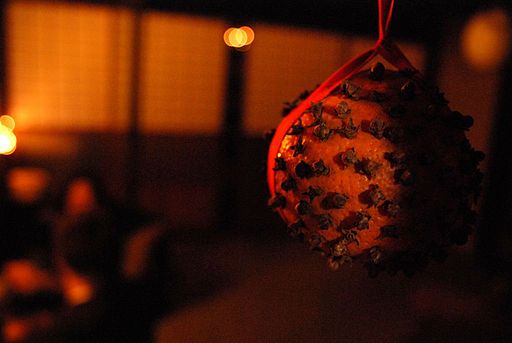In the tradition of the Victorians and Royalty alike, pomanders were used to mask odors. The sweet smelling scent will fill your home with citrus freshness.
Pomanders are a natural air freshener, and moth repellent. Place some in your clothes closets, drawers or simply stack several in a bowl for a beautiful display. Pomanders are typically made from various citrus fruit, mainly oranges as well as apples.
Pomanders
Supplies needed:
- Small or medium size unblemished fruit. (Oranges, Apples or Lemons)
- Masking tape or elastic bands
- Paper bag
- 20-25 grams large headed cloves
- Spice mixture: 1 tablespoon each: cinnamon, nutmeg, and ground cloves
- Knitting needle or fork or toothpick
- Thimble or masking tape to cover fingers.
- 4 drops sandalwood oil (a natural preservative)
- Ribbons for hanging pomanders.
Note: In traditional pomanders, orris root is used to act as a preservative and scent enhancer. Orris root is from the Iris bulb that has been dried and ground to a fine powder. Some people have shown allergic reactions to orris root, so we suggest you use sandalwood oil as an alternative preserver.
Let’s get started!
To begin, select fruit that is blemish free. Oranges are very suitable for this project.
Mix the spices with the Sandalwood oil in a bowl or bag and set aside. Cover fingers with masking tape or thimbles when making the holes for the cloves, otherwise it can be painful after awhile. At this point, if you want to decorate the pomander with ribbons, using masking tape, make a crisscross design on the fruit.
This will be the marked off area when the ribbons will be. Using the knitting needles or something similar, poke holes starting from the top of the orange straight down to the bottom, inserting cloves as you go along.
Continue this all around the fruit until it is completely covered in cloves. Make sure the hole is about double the size of the clove stem, since the orange will shrink to about half its original size. Maximum spacing between cloves should be no more than 1/4 inch, the closer together the better. Once the orange is clove studded, place the spices in a paper bag. (Do not use plastic bags as it will prevent the pomander from curing properly). Roll the orange in the spices until it is completely and evenly coated. Next leave the orange in the bag and place in a cool, dry area for approximately 4-6 weeks to dry the pomander out. Roll the orange in the spices daily. Note: If you notice any mold or the orange decomposing then throw it out. Curing time varies anywhere from 3 weeks to 6 months. On average it’s about 3 1/2 weeks. To check if your pomander is dried, it should sound hollow when tapped with your knuckle, and feel light in weight. Once dried, shake off any excess spices. You pomander is now ready to fill your house with the sweet spicy scent that has been enjoyed since the Victorian era and beyond.
Decorating the pomander: Place ribbons in a criss-cross fashion where the tape was placed or elastic bands. Sew the ends together and make a loop for hanging.
Pomanders look beautiful when several of them are placed in a bowl together. In this case ribbons are not necessary.
Pomanders last many many years. When the scent starts to fade, add a few drops of clove oil to your spice mixture and reroll in the spices.
The Author:
Pioneerthinking.com – Ingredients for a Simple Life
Copyright Pioneerthinking.com 2003 – For personal use only.

So… Is it really necessary to use the sandalwood oil?
I wanted to make quite a few of these for gifts,
And realized how pricey the oil is.
No, you certainly don’t need the oil.
I live in a humid hot climate. It’s a bit buggy. Is it ok to wrap in tin foil and let it dry out in the refrig? Thanks
My oranges tend to get spoilt and start dripping
Help
I just put the cloves and kept aside
Did not use any oil
The oil is a preservative. You really need to include it as otherwise the oranges will spoil and drip like you say. You also need to include the period of drying out to make sure they properly cure. Including more cloves around the outside of the orange might help as well, as clove oil is a natural antifungal and antibacterial preservative.
Where can I buy whole cloves in bulk? I know they are very expensive in small bottles from the stores-would appreciate any advice you may have or know- Thanks <3